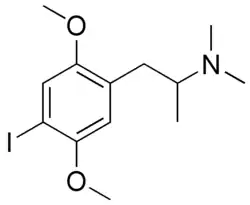IDNNA
 | |
| Names | |
|---|---|
| Preferred IUPAC name
1-(4-Iodo-2,5-dimethoxyphenyl)-N,N-dimethylpropan-2-amine | |
| Other names
2,5-Dimethoxy-4-iodo-N,N-dimethylamphetamine
2,5-Dimethoxy-4-iodo-1-ethyl-(α-methyl)amine; N,N-Dimethyl-DOI | |
| Identifiers | |
3D model (JSmol)
|
|
| ChEMBL | |
| ChemSpider | |
PubChem CID
|
|
| UNII | |
CompTox Dashboard (EPA)
|
|
| |
| |
| Properties | |
| C13H20NO2I | |
| Molar mass | 349.211 g/mol |
Except where otherwise noted, data are given for materials in their standard state (at 25 °C [77 °F], 100 kPa).
Infobox references
| |
IDNNA, also known as 2,5-dimethoxy-4-iodo-N,N-dimethylamphetamine or as N,N-dimethyl-DOI, is a lesser-known psychedelic drug and a substituted amphetamine. It is also the N,N-dimethyl analog of DOI. IDNNA was first synthesized by Alexander Shulgin. In his book PiHKAL, the minimum dosage is listed as 2.6 mg, and the duration unknown.[1] IDNNA produces few to no effects. Very little data exists about the pharmacological properties, metabolism, and toxicity of IDNNA.
Society and culture
Legal status
United Kingdom
This substance is a Class A drug in the Drugs controlled by the UK Misuse of Drugs Act.[2]
See also
- DOx (psychedelics)
- N-Methyl-DOI
- Methyl-DOB (N-methyl-DOB)
- N-Methyl-2C-I
- N-Methyl-2C-B
- Beatrice (N-methyl-DOM)
- N-Methyl-DOET
References
- ^ IDNNA Entry in PiHKAL
- ^ "UK Misuse of Drugs act 2001 Amendment summary". Isomer Design. Archived from the original on 22 October 2017. Retrieved 12 March 2014.